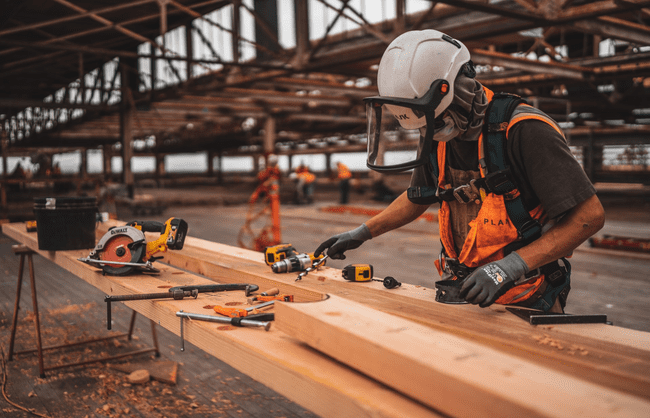Researchers Develop Earthquake-Resistant Concrete

In cities and towns prone to earthquakes, building codes require specific tests for any masonry used to construct new buildings. In California, for example, brick walls must meet code specification for facing, bonding and distance between headers. Wall anchors are tested and must adhere to strict coding requirements. With that being said, older buildings in California have yet to be retrofitted – leaving it up to the owners to do so. This process is not only costly but rather complicated depending upon the type of building.
UBC’s Earthquake-Proof Concrete

There may be a solution. Thanks to a group of Canadian researchers at the University of British Columbia, there’s a new way to retrofit buildings with an earthquake-proof material that is coated on existing walls. Capable of withstanding a 9.0 to 9.1 magnitude earthquake (similar to the Tohoku, Japan quake in 2011), UBC’s new groundbreaking mixture fortifies existing concrete walls that would normally crumble under the duress of a powerful seismic event.
The “seismic-resistant, fiber-reinforced concrete,” according to a recent press release from UBC is “similar to steel, designed to be strong, malleable, and ductile.” Called eco-friendly ductile cementitious composite (EDCC), the cutting-edge mixture can be easily applied to the surface of an existing wall – making it earthquake-resistant. This rather innovative mixture is designed for one purpose: to save lives.
Eco-Friendly Ductile Cementitious Composite (EDCC)

“We sprayed a number of walls with a 10 millimeter-thick layer of EDCC, which is sufficient to reinforce most interior walls against seismic shocks,” says Salman Soleimani-Dashtaki, a Ph.D. candidate in the department of civil engineering at UBC. “Then we subjected them to Tohoku-level quakes and other types and intensities of earthquakes—and we couldn’t break them.”
EDCC combines cement with polymer-based fibers, flyash, and other industrial additives, making it highly sustainable, according to UBC civil engineering professor Nemy Banthia, who supervised the work. In initial lab tests, the 10 mm-thick layer of EDCC was applied to walls made of traditional concrete blocks. After going through rigorous earthquake testing, which involved simulating a 9.1-magnitude seismic event, the EDCC walls help up without any crumbling. That was not the case for the concrete walls without the EDCC. They turned into rubble almost immediately.
Cement Production and Greenhouse Gas Emissions

With close to 70% of the composite made of Flyash, an industrial by-product, not only is the EDCC material the perfect strengthening substance for buildings in earthquake-prone cities, but it also reduces the harmful greenhouse gases normally produced when manufacturing concrete. It’s a win-win for everyone involved. “By replacing nearly 70% of cement with flyash, an industrial byproduct, we can reduce the amount of cement used,” said Banthia. “This is quite an urgent requirement as one ton of cement production releases almost a ton of carbon dioxide into the atmosphere, and the cement industry produces close to seven percent of global greenhouse gas emissions.”
“This UBC-developed technology has far-reaching impact and could save the lives of not only British Columbians but citizens throughout the world,” said Advanced Education, Skills, and Training Minister Melanie Mark. “The earthquake-resistant concrete is a great example of how applied research at our public universities is developing the next generation of agents of change. The innovation and entrepreneurship being advanced at all of our post-secondary institutions is leading to cutting-edge technologies and helping to create a dynamic, modern B.C. economy that benefits all of us.”
EDCC’s Real-World Application

The first project on the docket for the team at the University of British Columbia: applying EDCC to the walls of Dr. Annie B Jamieson Elementary School located in Vancouver. The cutting-edge research was funded by the UBC-hosted Canada-India Research Centre of Excellence IC-IMPACTS, which promotes research collaboration between Canada and India. IC-IMPACTS will make EDCC available to retrofit a school in Roorkee in Uttarakhand, a highly seismic area in northern India.
“This technology is gaining significant attention in India and will provide our Canadian companies a strong competitive edge in the growing global infrastructure market,” added Banthia, who also serves as IC-IMPACTS scientific director.
Other EDCC applications include resilient homes for First Nations communities, pipelines, pavements, offshore platforms, blast-resistant structures, and industrial floors.
Safeguard Your Home with Concrete
In light of the most destructive wildfire in California’s history (destroying at least 5,700 buildings and counting) and the catastrophic damage caused by Hurricane Harvey (damaging 185,149 homes in Texas), moving away from the traditional wood frame construction in favor of reinforced concrete may be a wise decision, especially if your property is vulnerable to severe weather conditions or forest fires. If you want the best deal possible on a home equity loan – giving you multiple offers in a matter of minutes – click here to compare rates on Lending Tree’s leading online marketplace.

Source: University of British Columbia, New Atlas






